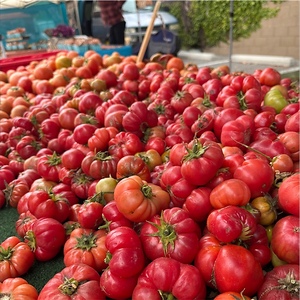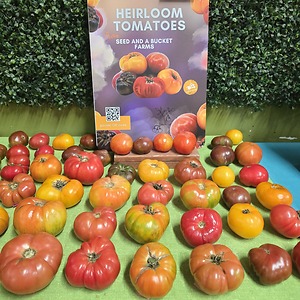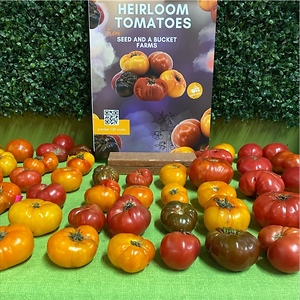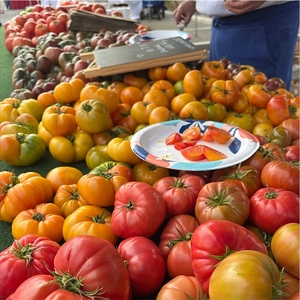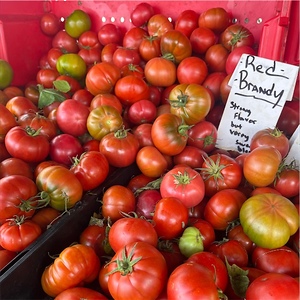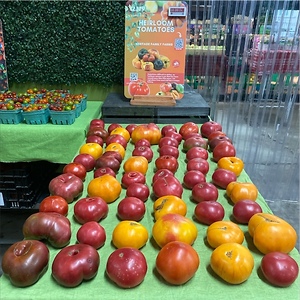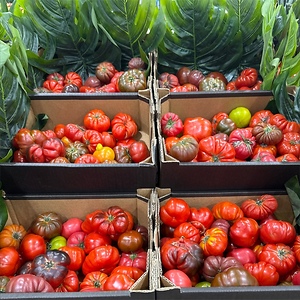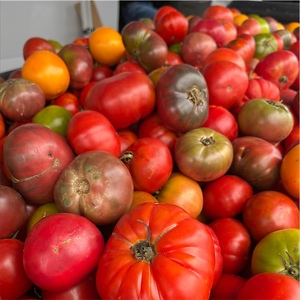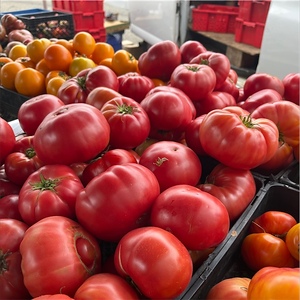

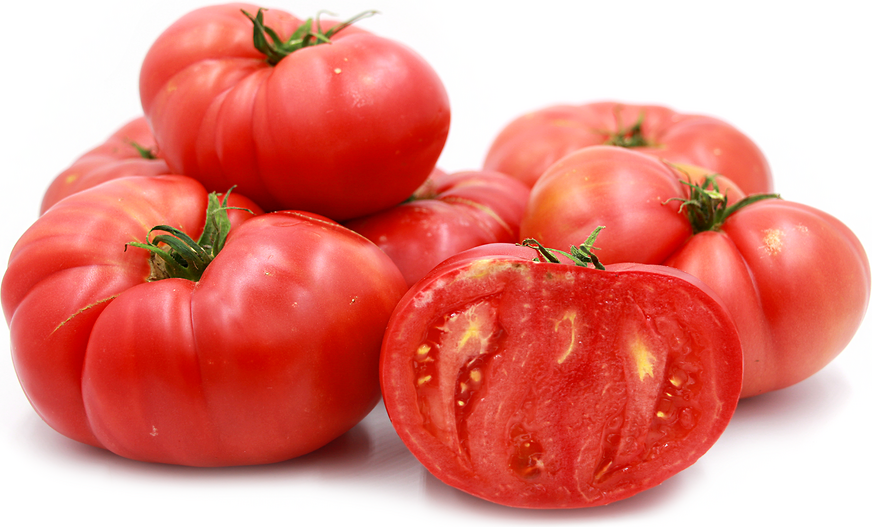
Brandywine Heirloom Tomatoes
Estimated Inventory, 10 lbs : 0
Description/Taste
Brandywine tomatoes are medium to large in size, able to grow as large as 16 to 17 centimeters in diameter, and have a plump, round to oblate, flattened, curved shape. Depending on the variety, Brandywine tomatoes can weigh 8 to 12 ounces, sometimes as heavy as 32 ounces. The tomato’s skin is thin, smooth, firm, and taut with a faint sheen. The surface is also covered in ridges, giving the skin an irregular, folded, or creased appearance. Brandywine tomatoes ripen from green to shades of red, pink, or yellow, based on the type, and are topped with a cap of dark green, thin leaves. Underneath the surface, the red flesh is dense and has portions of tender, succulent meat filled with chambers of gelatinous liquid. The flesh encases only a few edible seeds and is soft and juicy. Brandywine tomatoes release a strong, fruity, floral, and savory aroma and should feel heavy for their size when ripe. The tomatoes can be eaten raw or cooked and have a sweet, fruity, earthy, and subtly bitter taste balanced with low acidity. Darker Brandywine tomatoes are said to have a sweeter, richer taste, while lighter-hued tomatoes are noted for their tangier flavors.
Seasons/Availability
Brandywine tomatoes are harvested in the late summer through fall.
Current Facts
Brandywine tomatoes, botanically classified as Solanum lycopersicum, is a category encompassing several types of tomatoes belonging to the Solanaceae or nightshade family. Many varieties of Brandywine tomatoes grown worldwide are found in varying colors, and pink and red strains are generally the most common in home gardens. Pink and Red Brandywine tomatoes are also often mislabeled or interchangeably sold under both names, making distinguishing between the two types challenging. Brandywine tomatoes are harvested mid-season and grow on indeterminate, vining plants. The climbing vines can extend 2 to 4 meters in height and produce clusters of large, slightly flattened tomatoes. Brandywine tomatoes are also slow maturing, ripening 80 to 100 days after transplanting. The tomatoes are considered a type of beefsteak tomato, a descriptor used for their size and flavor, and growers value the plants for their hardiness, high yields, disease resistance, and even ripening. Brandywine tomatoes can be grown in greenhouses or outdoors and are among the most popular home garden tomatoes in the United States. The thin-skinned tomatoes are not typically cultivated for commercial markets, but some specialty stores seasonally carry them as premium tomatoes. Brandywine tomatoes are famous for their rich and balanced flavor and are used in a wide array of raw and cooked culinary preparations.
Nutritional Value
Brandywine tomatoes are not extensively studied for their nutritional properties. Like other red tomato cultivars, they are a source of vitamin C to boost the immune system, fiber to regulate the digestive tract, and potassium to balance fluid levels within the body. The variety also provides vitamin A to maintain healthy organ functions, vitamin D to aid the body in absorbing calcium, phosphorus to repair tissues, small amounts of zinc, and lycopene, an antioxidant to protect the cells against the damage caused by free radicals.
Applications
Brandywine tomatoes have a balanced, sweet, fruity, subtly earthy, and full-bodied flavor suited for fresh and cooked preparations. The variety is popularly consumed out of hand and can be served as a simple dish with fresh herbs and a sprinkling of salt. Brandywine tomatoes can be sliced and tossed into salads, used in salsa or as a topping over tacos, or chopped for bruschetta. The tomatoes can also be used in caprese, blended into juices, or sliced and served on sandwiches and burgers. In addition to fresh preparations, Brandywine tomatoes caramelize when cooked and develop richer, more concentrated flavor nuances. The variety can be sliced and layered on flatbreads and pizza, baked into tarts and tomato pies, or cooked into omelets and frittatas. They can also be simmered into sauces, added to casseroles, or incorporated into soups, stews, and curries. Brandywine tomatoes can be used in any recipe calling for beefsteak tomatoes. The variety pairs well with corn, eggplant, broccoli, watermelon, aromatics such as garlic, red onions, ginger, and chile peppers, herbs including cilantro, basil, and parsley, and cheeses such as mozzarella, cheddar, and parmesan. Whole, unopened Brandywine tomatoes have a short shelf life and should be consumed within a few days of becoming ripe. Once sliced, the tomatoes should be wrapped in plastic or stored in a sealed container in the refrigerator. Brandywine tomatoes can also be frozen for up to six months or dried for extended use.
Ethnic/Cultural Info
Brandywine tomatoes are thought to have been named after the Brandywine Creek in Pennsylvania. One of the only references to this theory is traced to Thomas H. Brinton, an American tomato grower based in Chadd’s Ford, Pennsylvania. Brinton was well-known throughout the American tomato industry as a reputable source of knowledge as he grew over 100 varieties, and on September 25th, 1888, he wrote about a tomato called No. 45. Brinton noted the variety should be called Brandywine, named after, in his opinion, one of the most beautiful streams in Pennsylvania. While this theory has not been supported beyond this mention by Brinton, another tale became woven into the story of Brandywine, saying the variety may be of Amish origins. There is no evidence to confirm or deny this claim, but the Amish connection was created as areas near Brandywine Creek included Amish communities.
Geography/History
The history of Brandywine tomatoes is convoluted and heavily debated among historians and tomato experts. Tomato varieties similar in appearance and flavor to Brandywine first appeared in American seed catalogs in the 1800s. They were listed in the Burpee catalog in 1892, and Johnson and Stokes mentioned a similar variety in late 1899. These catalog listings are vague, and some experts are unsure if they are true Brandywines, but the late 1800s marked the first signs of what could have been Brandywine. The original strain, known as Sudduth’s Strain or Pink Brandywine, officially appeared under this name through the Seed Savers Exchange in 1982. The variety was said to have arisen from Dorris Sudduth Hill, a grower in Murfreesboro, Tennessee. The family had allegedly been growing the variety for over 80 years and had been saving its seeds since the 1800s. Dorris Sudduth Hill sent seeds to Ohio gardener Ben Quisenberry, who in turn gave them to Seed Savers Exchange in 1982. It is unknown if the original Brandywine strain is native to the United States or came from Europe. Since its introduction, Brandywine tomatoes have been extensively cultivated, with growers saving and sharing seeds. These seed exchanges have led to many sub-strains and cultivars that have been incorrectly labeled, making it difficult to classify and trace the origins of Brandywine. Red Brandywine tomatoes first appeared in 1984, but experts believe this was a mislabeling of a Pink Brandywine. True Red Brandywine tomatoes were listed by Steve Miller in 1988. Miller acquired the seeds from Tom Hauch of Heirloom Seeds, who said he found the seeds through farmers in Chester County, Pennsylvania, in 1885. Today, Red Brandywine tomatoes are often sold interchangeably with Pink Brandywine varieties. It is challenging to distinguish between the two in markets as the coloring can appear similar, but both types are widely grown in home gardens as culinary tomatoes in the United States. Brandywine tomatoes can also be seasonally found through select farmer’s markets, and some specialty retailers will carry the variety.
Recipe Ideas
Recipes that include Brandywine Heirloom Tomatoes. One
| Seasonal Wisdom |
|
Classic Heirloom Tomato Sauce |
| The Garden Grazer |
|
Fresh Tomato Basil Pasta with Lemon & Garlic |
| Delish |
|
Parmesan Tuiles with Heirloom Tomato Salad |
Podcast



